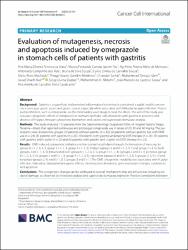| dc.description.abstract | Background: Gastritis is a superfcial and prevalent infammatory lesion that is considered a public health concern
once can cause gastric ulcers and gastric cancer, especially when associated with Helicobacter pylori infection. Proton
pump inhibitors, such as omeprazole, are the most widely used drugs to treat this illness. The aim of the study was
evaluate cytogenetic efects of omeprazole in stomach epithelial cells of patients with gastritis in presence and
absence of H. pylori, through cytogenetic biomarkers and catalse and superoxide dismutase analysis.
Methods: The study included 152 patients from the Gastroenterology Outpatient Clinic of Hospital Getúlio Vargas,
Teresina—Brazil, that reported continuous and prolonged omeprazole use in doses of 20, 30 and 40 mg/kg. The par‑
ticipants were divided into groups: (1) patients without gastritis (n=32); (2) patients without gastritis but with OME
use (n=24); (3) patients with gastritis (n=26); (4) patients with gastritis undergoing OME therapy (n=26); (5) patients
with gastritis and H. pylori (n=22) and (6) patients with gastritis and H. pylori on OME therapy (n=22).
Results: OME induced cytogenetic imbalance in the stomach epithelium through the formation of micronuclei
(group 6>1, 2, 3, 4, 5; group 5>1, 2, 3; group 4>1, 2, 3); bridges (groups 4 and 6>1, 2, 3, 5 and group 2>3, 5); buds
(groups 2,4,6>, 1, 3, 5); binucleated cells (group 6>1, 2, 3, 4, 5; group 4>1, 2, 3); (groups 2 and 3>1); picnoses (group
6>1, 2, 3, 4, 5), groups 2 and 5>1, 3; group 4>1, 2, 3, 5); cariorrexis (groups 6 and 4>1, 2, 3, 5; groups 2, 3, 5>1) and
karyolysis (groups 2, 4, and 6>1, 3, 5; groups 3 and 5>1). The OME cytogenetic instability was associated with H. pylori
infection, indicating clastogenic/aneugenic efects, chromosomes alterations, gene expression changes, cytotoxicity
and apoptosis.
Conclusions: The cytogenetic changescan be attributed to several mechanisms that are still unclear, including oxi‑
dative damage, as observed by increased catalase and superoxide dismutase expresion. Positive correlations betwee | tr |















